Beautiful Plants For Your Interior
10 Most Common Butterflies in the UK

Every year, somewhere between July to August there’s a big event in the UK called the Big Butterfly Count. It encourages people in the UK to photograph butterflies and record the butterflies they see. In 2020, over 1.4 million butterflies were recorded!
Common Butterflies in the UK: Big Butterfly Count
The ‘Big Butterfly Count’ is an important conservation initiative that helps to track the health of butterfly populations across the UK. By encouraging people to record their butterfly sightings, the count provides valuable data that can be used to identify trends and threats to butterfly populations. This information can then be used to develop conservation strategies to protect butterflies and their habitats.
With data collected from across the UK over the past years, here are the 10 most popular butterflies in the UK including their pictures for you to make your ID simpler.
The Large White Butterfly
The Gatekeeper Butterfly
The Peacock Butterfly
The Meadow Brown Butterfly
The Red Admiral Butterfly
The Small Tortoiseshell Butterfly
The Common Blue Butterfly
The Ringlet Butterfly
The Comma Butterfly
The Small Copper Butterfly
1. The Large White Butterfly (Pieris brassicae)
The Large White butterfly is white with black dots. There are 2 dots and a black ‘dash’ on each wing for the female and 1 for the male. The Large White Butterfly, also known as Pieris brassicae, is a common sight in gardens and open spaces across the UK and Europe. With its distinctive white wings and black markings, this butterfly is a symbol of beauty and grace in the natural world.
However, its presence can be a cause for concern among gardeners, as the caterpillars of the ‘Large White Butterfly’ are known to feed on cabbage and other cruciferous (Brassicaceae) plants. Despite this, ‘The Large White Butterfly’ continues to captivate observers with its elegant flight and striking appearance. Some people think white butterflies mean good luck.”
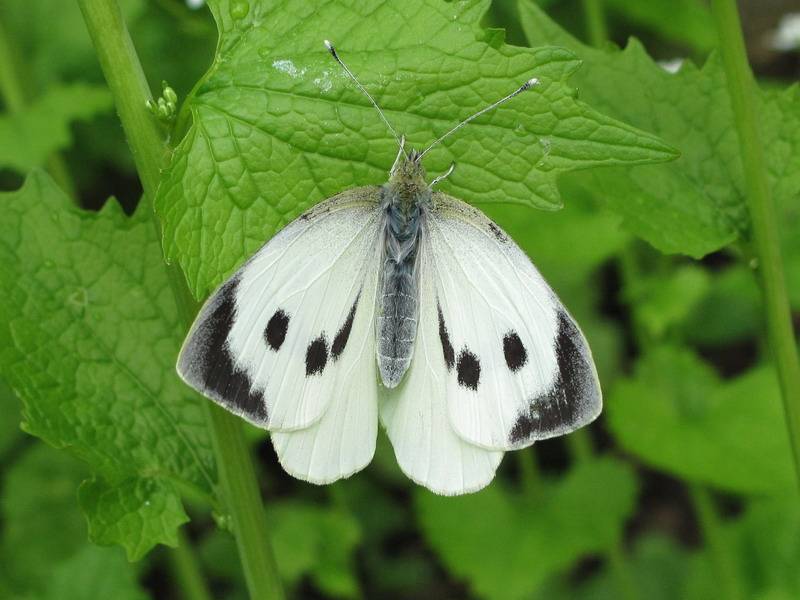
Common Butterflies in the UK: The Large White Butterfly (Female)
2. The Gatekeeper (Pyronia tithonus)
The Gatekeeper butterfly is a common sight in the UK and other parts of Europe. This butterfly is known for its ‘orange’ wings with two large ‘brown spots’ and 2 white spots that look like ‘eyes’ within the larger brown spots. In addition, it has a ‘brown’ pattern on the wing edges which also helps with identification.
The Gatekeeper is often found in habitats with tall grasses near hedges, trees, or scrub, such as along hedgerows and in woodland rides. The Gatekeeper butterfly is a prime pollinator, often seen sipping nectar on sunny days. It is also referred to as the Hedge Brown butterfly and is fond of brambly hedgerows and ragwort-infested scrubland where nectar-bearing flowers are plentiful.
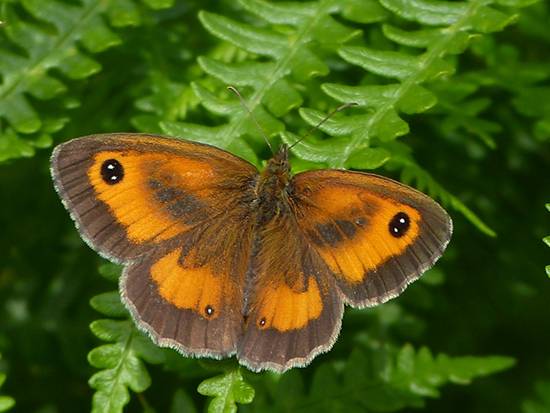
Common Butterflies in the UK: The ‘white spots’ of the Gatekeeper
3. The Peacock (Aglais io)
The Peacock butterfly is a striking and vibrantly coloured butterfly found in the UK and Europe. This butterfly is known for its beautiful “eyes” spots on its wings, which serve as a defence mechanism against predators.
The Peacock butterfly prefers temperate habitats such as woods, open fields, wildlife orientated gardens, and parks, it is widespread throughout the UK.
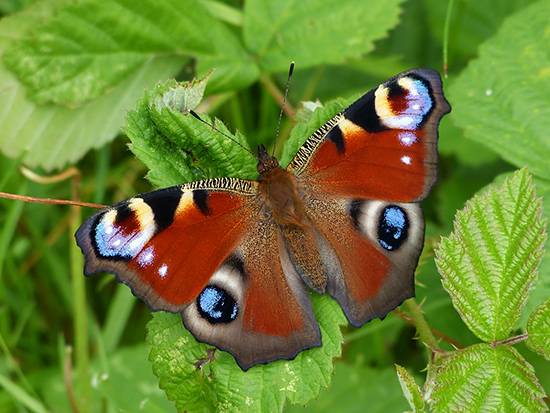
Common Butterflies in the UK: The ‘eyes’ of the Peacock butterfly
4. The Meadow Brown (Maniola jurtina)
The Meadow Brown butterfly, with its light brown colour, is one of the most common butterflies in the UK and is a widespread species found across Europe. This medium-sized butterfly is known for its predominantly brown wings with a distinctive eyespot.
It is often found in grasslands, including downland (chalk downs), heathland, coastal dunes, and gardens, making it one of the most abundant butterfly species in many habitats.
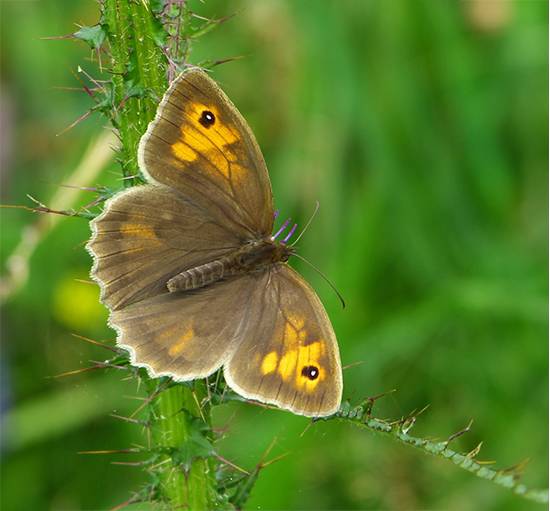
Common Butterflies in the UK: The ‘eye spots’ of the Meadow Brown butterfly
5. The Red Admiral Butterfly (Vanessa atalanta)
The Red Admiral butterfly is widespread and can be found in various habitats across the UK where it is common, and Europe.
The Red Admiral butterfly is a well-characterised butterfly. The adult butterfly is a strong and agile flyer, often seen in gardens, parks, and other open spaces. It is known for its distinctive black colouration with red-orange bands on the forewings and white spots.
The Red Admiral butterfly is also recognised for its migratory behaviour, as this species is a frequent visitor to gardens it is particularly attracted to nectar-rich flowers such as buddleia, flowering ivy, and even rotting fruit.”

Common Butterflies in the UK: The orange banding and white spots of the Red Admiral
6. The Small Tortoiseshell (Aglais urticae)
The Small Tortoiseshell butterfly is a colourful and widespread butterfly found all across the UK. This species is well-known for its striking orange and black wings with blue spots along the wing margins. The Small Tortoiseshell butterfly is a familiar sight in gardens, open spaces, and woodland edges, where it feeds on nectar from various flowers and lays their eggs on the undersides of stinging nettles.
Interestingly, this butterfly is known to hibernate in its adult form, often seeking shelter in our buildings and garden sheds during the winter months. Its adaptability and ability to thrive in diverse habitats have contributed to its status as one of the most successful and recognisable butterflies throughout the UK.
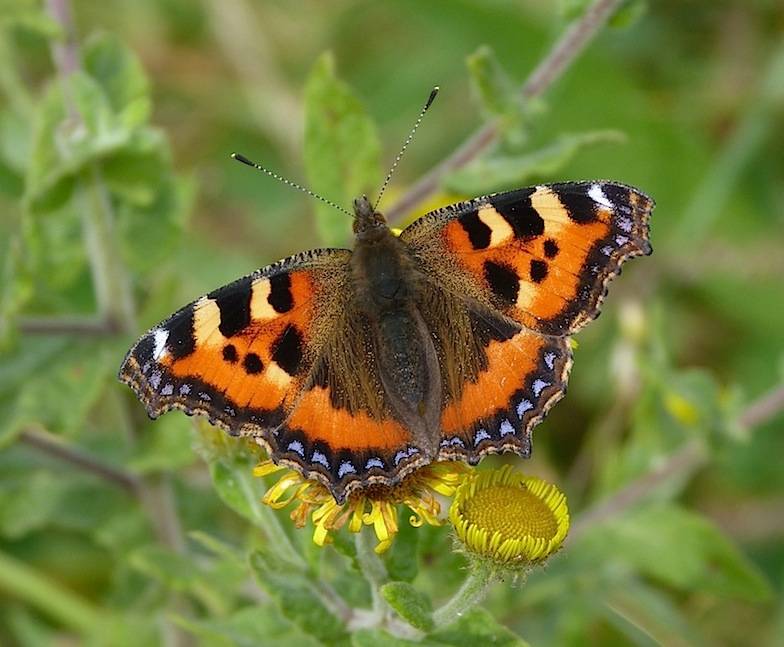
Common Butterflies in the UK: The small Tortoiseshell butterfly, note the blue dots on the edge of the wings.
7. The Common Blue (Polyommatus icarus)
The Common Blue butterfly is a small and widespread butterfly found in various habitats across Europe, including the UK. This species is known for its ‘delicate’ blue wings in males, while females display a more subdued colouration with varying degrees of blue and brown.
The Common Blue butterfly is often found in flowery or grassy areas, including heathland, open woodland, and grassy meadows. It primarily feeds on nectar from a variety of flowers, such as clover and bird’s foot trefoil. This adaptable butterfly is a familiar sight during the summer months and contributes to the colourful tapestry of meadows and grasslands across its range.
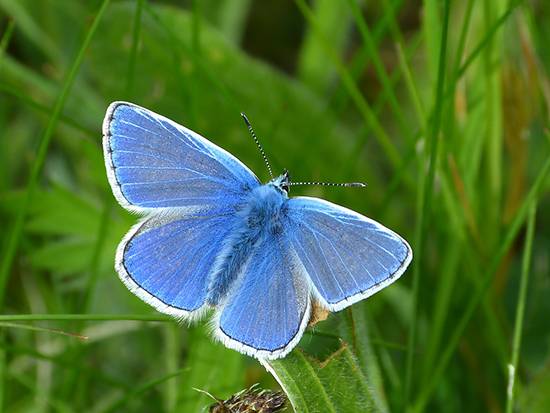
Common Butterflies in the UK: The delicate blue colouring of the male Common Blue butterfly
8. The Ringlet (Aphantopus hyperantus)
The ‘Ringlet butterfly’, is a species commonly found in the UK and throughout Europe. The Ringlet butterfly is brown with eye-like markings on its wings. It is sometimes mistaken for the ‘Meadow Brown’, but the Ringlet is a darker brown.
This butterfly favours damp, shaded areas in open woodlands, clearings, damp grassy road verges, and meadows. It has a wingspan of approximately 2in (50 mm), with males generally smaller and darker than females. This species is known for ‘hibernating’ while in the 3rd instar, with occasional feeding on warm evenings during the winter.
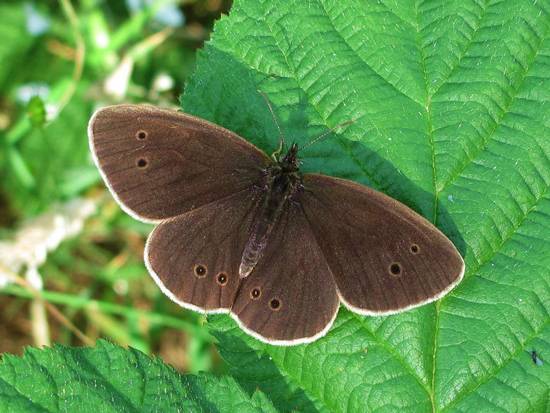
Common Butterflies in the UK: The Ringlet Butterfly has several eye like markings (ringlets) on its wings
9. The Comma (Polygonia c-album)
The Comma butterfly is a fascinating species found in various habitats across the UK and Europe. It is characterised by its distinctive ‘scalloped’ wing edges and great colouration, which conceals hibernating adults amongst ‘dead’ leaves.
The name “Comma” is derived from the tiny ‘white’ mark on the underside of the hindwing, resembling a comma punctuation mark. This butterfly is primarily a woodland species, often seen along open woodland and country lanes, and it is known for its adaptability and ability to thrive in very diverse environments.
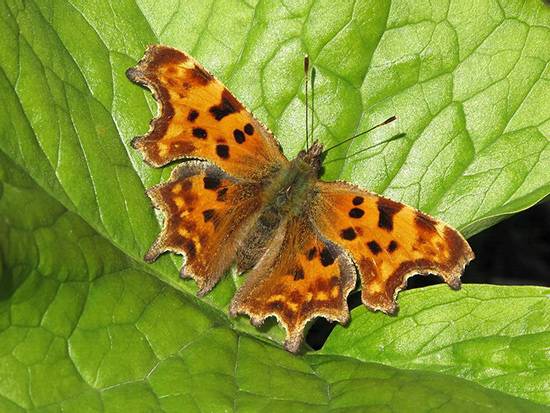
Common Butterflies in the UK: The Comma Butterfly with scalloped shaped wings.
10. Small Copper (Lycaena phlaeas)
The Small Copper butterfly is a striking species found in a variety of habitats across Europe, including the UK. This butterfly is characterised by its bright orange forewings with black spots and distinctive black and white markings on the underside of its wings.
The Small Copper butterfly is commonly found in open grasslands, gardens, riverbanks, woodland clearings, and even waste ground. It is known for its preference for dry, sunny habitats and its habit of basking in the sun to absorb its rays. This adaptable butterfly is a delightful sight in both a natural and urban environment.

Common Butterflies in the UK: The Small Copper Butterfly can be found on wasteland as well as woods and gardens.
FAQs
What Can You Do To Help Conserve Butterflies In The UK?
There are many things you can do to help conserve butterflies in the UK. These include:
Create a butterfly-friendly garden: Plant a variety of nectar-rich flowers, such as lavender, marigolds, and buddleia.
Avoid using pesticides: Pesticides can harm butterflies and other pollinators. Choose organic gardening methods whenever possible.
Report butterfly sightings: The Big Butterfly Count is an annual event that encourages people to record their butterfly sightings. This information is used to track butterfly populations and identify trends.
When Can I See The Most Butterflies In The UK?
Generally, the best time to see butterflies in the UK is during the summer months, from May to September. This is when the weather is warm and sunny, and there is an abundance of nectar-rich flowers for them to feed on.
Conclusion
The UK is a place with many different species of butterflies. They are beautiful and have distinct features. They add bright colours and delicate movements to our gardens, fields, and woodlands. We can help these butterflies survive for many years to come by taking proactive measures to protect their habitats and ensuring a steady supply of food sources.
